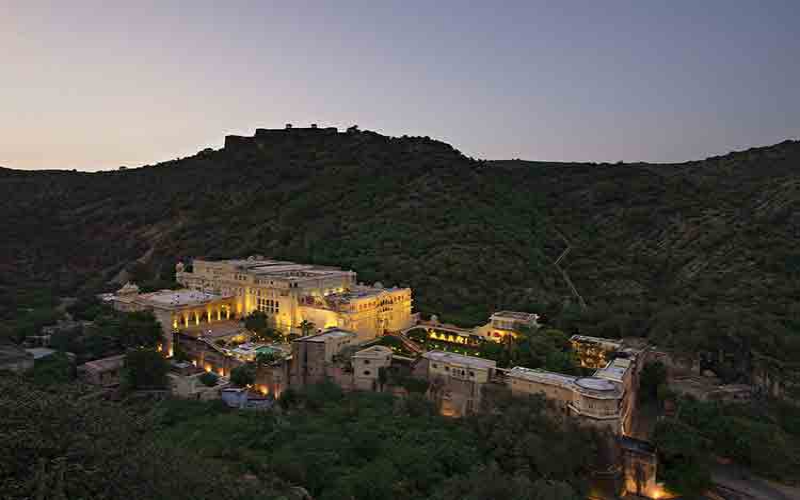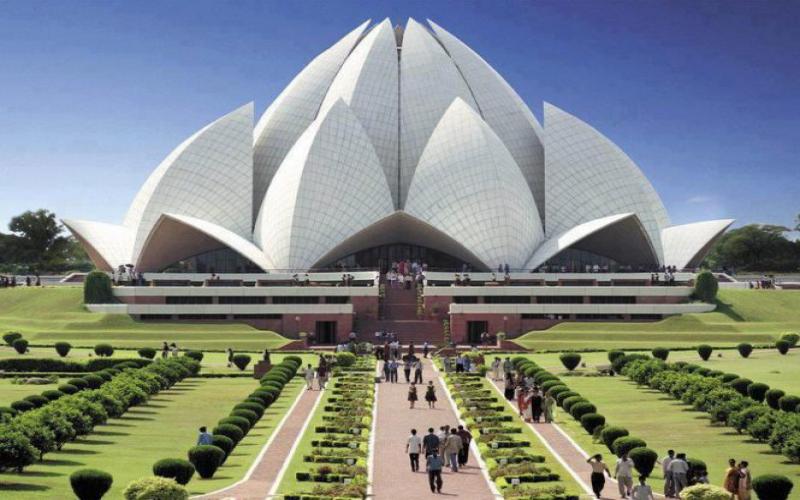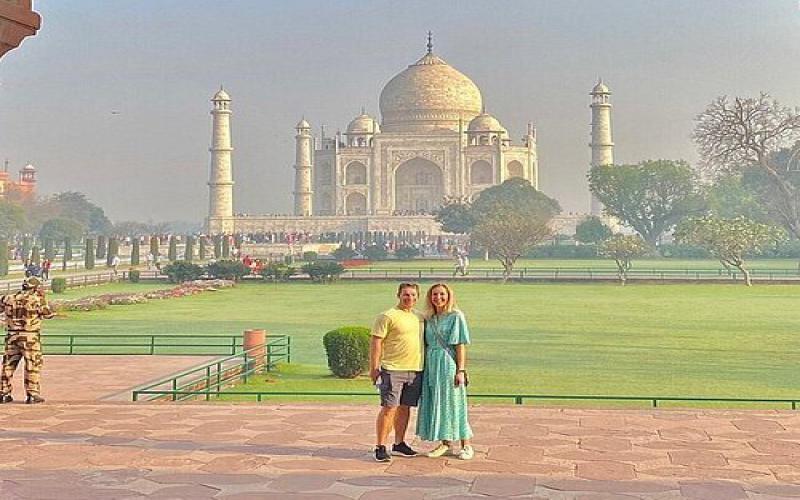India's Golden Triangle Tour with Samode



Duration - 8 Nights / 9 Days
Price -
Destination -
DAY 1 : Day 1 Arrival at Delhi |
| Company representatives will receive you on arrival at the international airport in Delhi. Transfer to your hotel. Relax. DELHI, the capital of kingdoms and empires is now a sprawling metropolis with a fascinating blend of the past and the present. It is a perfect introduction to the composite culture of an ancient land. A window to the kaleidoscope - that is India. Overnight will be at Delhi |
DAY 2 : Day 2 Delhi |
| Enjoy a guided tour of Old Delhi after breakfast. The tour will begin with a visit to Raj Ghat, a simple memorial to Mahatma Gandhi. He is also famously known as the "father of the nation". One of the most important buildings of Old Delhi is the RED FORT. The magnificent Red Fort was built during the years 1638 - 48 when the Moghul Empire was at its peak. In 1638 Shahjahan transferred his capital from Agra to Delhi and laid the foundations of Shahjahanabad, the seventh city of Delhi. It is enclosed by a rubble stonewall, with bastions, gates and wickets at intervals. Of its fourteen gates, the important ones are the Mori, Lahori, Ajmeri, Turkman, Kashmiri and Delhi gates, some of which have already been demolished. His famous citadel, the Lal-Qila, or the Red Fort, lying at the town's northern end on the right bank or the Yamuna and south of Salimgarh, was begun in 1639 and completed after nine years. The Red Fort is different from the Agra fort and is better planned, because at its back lies the experience gained by Shahjahan at Agra, and because it was the work of one hand. It is an irregular octagon, with two long sides on the east and west, and with two main gates, one on the west and the other on the south, called Lahori and Delhi gates respectively. While the walls, gates and a few other structures in the fort are constructed of red sandstone, marble has been largely used in the palaces. Continue your tour to Jama Masjid by bicycle rickshaws, one of Asia's largest mosques. People stream in and out of the mosque continuously and the presence of a nearby bazaar means that the area is rarely quiet. Enjoy the rickshaw ride at Old Delhi peddling through the narrow by lanes of Chandani Chowk. After lunch proceed for a sightseeing tour of New Delhi, which reflects the legacy of the British left behind. The division between New and Old Delhi is the division between the capitals of the British and the Mughals respectively. The division in the walled city and New Delhi also marks the division in the life-styles. The walled city is all tradition where one will be able to glean a past life-style in all its facets, colors and spells. New Delhi in contrast, is a city trying to live up to the best of 21st century standards. Imperial Delhi will include the Qutub Minar, the tallest stone tower in India. Qutb-Minar in red and buff standstone is the highest tower in India. It has a diameter of 14.32 m at the base and about 2.75 m on the top with a height of 72.5 m. Qutbu'd-Din Aibak laid the foundation of Minar in AD 1199 for the use of the mu'azzin (crier) to give calls for prayer and raised the first floor, to which were added three more floors by his successor and son-in-law, Shamsu'd-Din Iltutmish (AD 1211-36). All the storeys are surrounded by a projected balcony encircling the minar and supported by stone brackets, which are decorated with honeycomb design, more conspicuously in the first floor. Next stop would be the majestic Humayun's Tomb. Humayun died in 1556, and his widow Hamida Banu Begum, also known as Haji Begum, commenced the construction of his tomb in 1569, fourteen years after his death. It is the first distinct example of proper Mughal style, which was inspired by Persian architecture. It is well known that Humayun picked up the principles of Persian architecture during his exile, and he himself is likely to have planned the tomb, although there is no record to that effect. The tour also includes a drive past the imposing India Gate, the Parliament building and the Rastrapathi Bhawan, the President's residence. If time permits then visit the Lotus temple located in south of Delhi. It is lotus shaped and has rightly been given the name. It is made of marble, cement, dolomite and sand. It is open to all faiths and is an ideal place for meditation and obtaining peace and tranquillity. Its founder, Bahaullah (1817-1892), is regarded by Bahai as the most recent in the line of Messengers of God that stretches back beyond recorded time and that includes Abraham, Moses, Buddha, Zoroaster, Christ and Muhammad. We could even have time to see the Indira Gandhi Museum or else Lotus Temple can be replaced with the museum visit. The history of the Gandhi family is well documented in this old building which was the last residence of Mrs Gandhi. Overnight will be at Delhi. |
DAY 3 : Day 3 Delhi - Delhi - Sikandra - Agra by Road |
| Early morning you will be transferred to the railway station to board train for Agra. Reach Agra and proceed for sightseeing of SIKANDARA. SIKANDRA - This beautifully maintained monument is where EMPEROR AKBAR was buried. It is a very low profile monument but it has one of the most awe - inspiring tombs. It is surreal how one of the greatest emperors has been put to rest. The manicured lawns has spotted and other varieties of deer roaming in them. Come back and check into the hotel. AGRA: Two great Mughal monarchs, Akbar and Shah Jahan, transformed the little village of Agra into a befitting second capital of the Mughal Empire - giving it the name Dar-ul-Khilafat {seat of the Emperor}. Today a visitor to Agra is caught up in a world of contrasting edifices, of red sandstone and white marble, narrow galleys and quaint buggies, and that irresistible charm that this favorite city of the Mughals still retains. It is not surprising, that modern Agra still reflects its Mughal heritage most conspicuously. A walk down the narrow bustling streets of the city will introduce the visitor to the wafting aroma of Mughlai cuisine. Overnight will be at Agra. |
DAY 4 : Day 4 Agra |
| Proceed for a sunrise view of the Taj Mahal. TAJ MAHAL - Little needs to be said about this architectural wonder which is always the soul raison-de-etre for every tourist's visit to Agra. Built by Shah Jahan, the Taj is a white marble memorial to his beautiful wife Mumtaz Mahal. This monument took 22 years to be completed and was designed, and planned by Persian architect Ustad Isa. Apart from its stunning design balance and perfect symmetry, the Taj is also noted particularly for its elegant domes, intricately carved screens and some of the best inlay work ever seen. Return back to the hotel for breakfast. Proceed for an afternoon visit of Agra Fort. AGRA FORT - Built by the famed Mughal emperor Akbar in 1565 AD, the fort is predominantly of red sandstone. Ensconced within is the picture perfect Pearl Mosque, which is a major tourist attraction. It lies on the bend of the river Yamuna, almost in the heart of the town. Akbar built it as his citadel over the years 1563-73 in the finest architectural style. It has imposing gates and walls of red sandstone and a moat. After Agra Fort we will visit BABY TAJ - The interiors of which are considered better than the Taj. Overnight will be at Agra. |
DAY 5 : Day 5 Agra - Fatehpur Sikri - Bharatpur by road | Bharatpur - Jaipur |
| After breakfast proceed to visit Fatehpur Sikri. The deserted, red Sandstone City, Emperor Akbar built that as his capital and palace in the late 16th century is an exhilarating experience. It a veritable fairytale city and its "ruins" are in pristine condition... it's not hard to imagine what the court life must have been like in the days of its grandeur. Also visit the Bulund Darwaza, the largest gateway in the world. After the sightseeing, proceed for Jaipur and on your way stop at Bharatpur. Bharatpur, an erstwhile princely state of the Jat rulers, was founded by the great Maharaja Suraj Mal, who also once conquered Delhi. Maharaja Suraj Mal built the fort at Bharatpur as also the beautiful palaces and gardens at Deeg. The Keoladeo Ghana National Park is one of the finest water-bird sanctuaries in the world. The Maharaja of Bharatpur artificially created the lake and wetland in the 19th century. The marshes of Keoladeo (area 24 sq km, established in 1956 as a bird sanctuary, 1981 as a National Park), were the private hunting reserves of the Maharajas, and was developed in the late 19th century by creating small dams to collect rain water and by feeding it with an irrigation canal. Over the years, the lakes attracted great numbers of waterfowl and the Maharajas held grand shoots with family, friends and visiting dignitaries. Commonly referred to as Bharatpur, the Park is a delight for bird watchers. Over 375 species of birds are found here and raised paths, camouflaged by babul trees and undergrowth make viewing easy. A quiet ride by boat in the early hours of the morning is also unforgettable experience. The cacophony is unbelievable as painted storks, open bills, spoonbills, egrets, cormorants, white ibis and multitudes of others, tend their young. Jacanas with their iridescent colors and elegant tail feathers and purple moorhen can be seen delicately treading over the floating vegetation. The Park has over 400 resident and migrant bird species, including the Common, Demoiselle and the rare . As well as mammals like Striped Hyena, Fishing Cat, Golden Jackal, Jungle Cat, Nilgai, Sambar, Blackbuck, wild Boar and Indian Python. Every year Bharatpur waits with bated breath for the arrival of the . There are only two wintering places for this rare species one in Iran and the other Bharatpur and these beautiful birds with their distinctive red beaks and facial patches, fly over 6400 km from their summer retreats. Colorful kingfishers, graceful pelican's rare and Trans- continental fliers - the migratory water - fowl are amongst the 375 species of birds found in the Keoladeo National Park. The most spectacular nesting is that of the egrets, storks, herons and cormorants, which make over 10,000 nests every year. This makes outstanding bird havens of the world. The park covers an area of 28.73km. The story of Bharatpur Bird Sanctuary is incomplete without an account of the migratory waterfowl. The most prominent waterfowl coming to this park are bareheaded and greyleg geese. Ducks also create a lot of fluttering in the lakes. The ducks usually found here are pintail, widgeon, common shelduck, shoveler, garganey, teal, etc. Attracted by the influx of the waterfowl the predatory birds-tawny eagles, spotted eagles short-toed eagles imperial eagles and fishing eagle also arrive. They all form the apex of the biological pyramid of the sanctuary and complete the avian food chain of the ecosystem. There are large herds of the nilgai, chital, wild boar and fear cows in addition to a few herds of sambar. You will have the option to proceed on a RICKSHAW for viewing the birds in Bharatpur and thereafter proceed for Jaipur. Reach and check into the hotel. Continue your drive to Jaipur and on arrival check-in at Hotel. Jaipur is the capital of the state of Rajasthan a romantic realm of resplendent palaces, mighty fortresses and regal Maharajahs that lies in the western deserts and is an utterly unique part of India. Proudly belonging to the KSHATRIYA warrior caste and fiercely independent, the Rajput princes made fearsome foes. However, many of them realized that to maintain their wealth and authority locally, it was expedient to proclaim allegiance to the central power. Thus, many enjoyed a privileged position under the Mughal emperors and also the British Raj that followed. The bustling Rajasthan capital of Jaipur takes its name from its venerated founder Jai Singh II, who was given the title Sawai Maharaja by the Mughal. Literally translated this would mean 'one and a quarter', suggesting that the Mughal thought this emperor to be more valuable than just 'one'. Jaipur is known as the 'Pink City' on account of the distinctive colour of its buildings. This did not, however, form part of the original plan, but dates back to 1856, when the city was given a wash of pink in honor of a State Visit from Prince Albert. This evening, visit the Birla Temple to learn more about the fascinating religious life of Jaipur. The marble structure, built as recently as 1985, houses ornate statues including one of Lakshmi (goddess of Wealth and Beauty) and Narayan dressed in gaudy robes, representing a Hindu vision of heavenly luxury. Carvings in the temple and on pillars supporting the covered walkways include images of the Hindu pantheon, as well as Jesus, the Blessed Virgin Mary and St Francis of Assisi. Your visit will coincide with the AARTI Ceremony, which involves oil lamps being lit and waved, in order to awake and invoke the deity. Enjoy the experience and spend night at Jaipur. |
DAY 6 : Day 6 Jaypur |
| Proceed for morning excursion to the Amber Fort. Ride to the Fort on elephant back in a royal manner. AMBER FORT PALACE - Amber is the classic romantic Rajasthani fort palace. Its construction was started by Man Singh I in 1592, and completed by his descendent Jai Singh I. Its forbidding exterior belies an inner paradise where a beautiful fusion of Mughal and Hindu styles finds its ultimate expression. Afternoon sightseeing tour of Jaipur visiting... CITY PALACE - A delightful blend of Mughal and traditional Rajasthani architecture, the City Palace sprawls over one-seventh of the area in the walled city. It houses the Chandra Mahal, Shri Govind Dev Temple and the City Palace Museum. JANTAR MANTAR - This is the largest and the best preserved of the five observatories built by Jai Singh II in different parts of the country. This observatory consisting of outsized astronomical instruments is still in use. HAWA MAHAL - The ornamental facade of this "Palace of Winds" is a prominent landmark in Jaipur. It is a five-storey structure of sandstone plastered pink encrusted with fine trelliswork and elaborate balconies. The palace has 953 niches and windows. Built in 1799 by Pratap Singh, the Mahal was a royal grandstand for the palace women. After the sightseeing, as per the timing, you could proceed to the hotel to relax or from could proceed directly to Chokhi Dhani. A perfect way to experience the rich culture and heritage of Rajasthan will be complete with a visit to Chokhi Dhani. Experience the rich warmth, the culture, traditions of a Rajasthan village, along with various dance and music performances at Chokhi Dhani. The place also displays local art and handicrafts for the tourists to take back home. Along with all this, people specially visit this place to enjoy the local cuisine. The local village people serve the food while you eat and display the tradition of a country were a guest is treated as a god. Away from the crowded city life, this is a perfect way of spending time and getting a closer look at the roots of the culture and traditions which tourists miss on. Overnight will be at Jaipur. |
DAY 7 : Day 7 Jaipur |
| Despues desayuno en Jaipur - Hoy el grupo tiene su dia libre para explorar esta ciudad de gran colores y actividades y bazares. Puedes visitar los mercados locales para comprar. |
DAY 8 : Day 8 Jaipur - Samode by road |
| Breakfast will be at hotel. Proceed for sightseeing of a royal village SAMODE. Samode according to the Rajputana Gazetteer of 1879 was a large and flourishing town. The Zamidars (landlords) of Samode - the principal thakurs of the state of Amber were the Nathawat clan from Chomu, a branch of the house of Amber, tracing their relation to the Jaipur Maharaja the fabled Prithviraj Singhji the 17th prince of the house of Kacchwaha Rajputs. Gopal Singhji one of his 12 sons was awarded Samode, a noble feudatory of the Amber & Jaipur principality. It was among the wealthiest territories in the Amber kingdom. The Zamidari eventually passed within the clan to the hands of Behari Das, a Rajput warrior in Mughal Service. After 6 generations in the hands of his descendants Samode was relinquished to the Raj. The 400-year-old SAMODE PALACE has a wealth of frescoes, many of them depicting religious subjects. The highlight is a vast DURBAR HALL. Take a walk of the Rajasthani village or take a camel cart ride. Overnight will be at Samode. |
DAY 9 : Day 9 Samode - Delhi by road |
| After breakfast, proceed for Delhi and reach by evening. Reach and transferred as per the flight timings, to the International Airport to board your flight back home with sweet memories of the Golden Triangle Tour. TOUR ENDS!!! |
Inclusion
Does Not IncludeNotes
|
 ACCOMMODATION AT MENTIONED HOTELS - 08 DOUBLE ROOM,
ACCOMMODATION AT MENTIONED HOTELS - 08 DOUBLE ROOM,